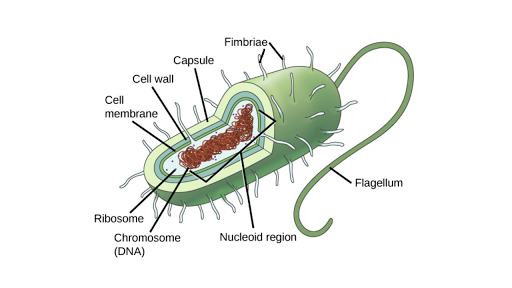What Best Describes a Cell That Is Prokaryotic
Therefore they do not have a nucleus but instead generally have a single chromosome. The statement that best describes a prokaryotic cell is option CA cell that does not contain membrane-bound organelles.

Prokaryotic Cell Definition Examples Structure Biology Dictionary
Which statement best describes a difference between prokaryotic cells and.

. Prokaryotes are organisms whose cells lack a nucleus and other organelles. Prokaryotic cells have a lower degree of complexity than eukaryotic cells. They both require chromosomes to be duplicated before division.
Due to this it does not have a nucleus but rather it have a single chromosome. For example the organelle nucleus found in these organisms are not surrounded by any nuclear membrane as seen in eukaryotes. Instead it is stored in a nucleoid that floats in the cells cytoplasm.
Which of the following best describes the cell below. Prokaryotic cells have membrane-bound organelles and eukaryotic cells do not have membrane-bound organelles. Both cell types contain DNA and ribosomes.
The bacteria and the archaea which scientists believe have unique evolutionary lineages. Question from Study island. Prokaryotes should be the unicellular organisms that lack organelles or other internal membrane-bound structures.
Which statement describes a cell process that is common to both eukaryotic and prokaryotic cells. They are both forms of mitosis. Eukaryotic cells have membrane-bound organelles while prokaryotic cells do not.
What is the difference between a prokaryotic and eukaryotic. Prokaryotic cells comprise bacteria and archaea. A prokaryotic cell are found in those organisms that lack membrane-bound organelles.
Prokaryotes can be divided into two. Therefore they require less genetic material. Group of answer choices.
Prokaryotic cells and eukaryotic cells reproduce by meiosis. Prokaryotes lack a cell membrane and therefore are unable to control what enters or exits the cell. Their genetic material isnt stored within a membrane-bound nucleus.
The endoplasmic reticulum is a network of membranes within the cell and it is often classified as rough or smooth depending on whether there are ribosomes on its surface. Eukaryotic cells have flagella while prokaryotic cells do not. In prokaryotic cells a dense centrally located region that contains DNA but is not surrounded by a membrane.
Which of the following statements best describes one major difference between prokaryotic cells and eukaryotic cells. This genetic material is packaged into PLASMIDS. Prokaryotes are divided into two distinct groups.
Prokaryotes are small and lack membrane-bound nuclei. Plasma membrane and nucleus D. Advertisement Advertisement 4804138921 4804138921 Answer.
A piece of circular double-stranded DNA located in an area of the cell called the nucleoid. Protein synthesis in a prokaryotic cell Which of the following best describes a characteristic of the process shown in Figure 1 that is unique to prokaryotes. Prokaryotes are unicellular organisms that lack organelles or other internal membrane-bound structures.
They are both used for sexual reproduction. 1 Which statement best describes a comparison of prokaryotic and eukaryotic cell division. Prokaryotic cell is a cell that has no membrane bound organelles but Eukaryotic cells has membrane bound organells.
Cell wall and chloroplast C. Prokaryotic cells have cell walls while eukaryotic cells do not. The translation of the mRNA is occurring while the.
A piece of circular double-stranded DNA should be located in an area of the cell known the nucleoid. Prokaryotes have less-complex cell organization and are generally smaller than eukaryotes. Most prokaryotic cells contain a single circular chromosome.
The mRNA is synthesized in a 5to 3direction. Eukaryotic cells are way more complex than prokaryotic cells because Eukaryotic cells contain membrane bound. These cells are much simpler than eukaryotic cells in terms of cytoplasmic organization.
The eukaryotic cells are so called because the genetic material is enclosed in nuclear envelope while in prokaryotes the genetic material is present in the cytoplasm. Plasma membrane and cytoplasm 2. So the correct answer is Prokaryotic cells do not have a membrane-bounded nucleus but.
Which best describes a difference between a prokaryotic cells and eukaryotic cells. Eukaryotes are more complex because they have organelles that are membrane bound such as the nuclei which contain their DNA. Both cell types use ribosomes to carry out translation.
Prokaryotic cells are generally larger than eukaryotic cells. They both involve dividing organelles evenly between daughter cells. Eukaryotic cells contain multiple noncircular linear chromosomes located in the nucleus.
Eukaryotic cells contain membrane-bound organelles while prokaryotic cells do not. They are cells haha. Organisms that are classified in the Bacteria and Archaea domains are prokaryotic cells.
Which two structures are common to both prokaryotic and eukaryotic cells. Prokaryotes have less-complex cell organization. Eukaryotes have a nuclear envelope separating their DNA from the rest of the cell which increases the likelihood of advantageous mutations.
Which domains of life are classified as prokaryotes quizlet. Prokaryotic cells are smaller and less complex than eukaryotic cells. Cell wall and nucleus B.
2 See answers Advertisement Advertisement einalem5665 einalem5665 AnswerC. В A single strand of the DNA is being used as a template for the transcription of the mRNA. Living organisms can be classified as prokaryotes or eukaryotes.

Prokaryotic And Eukaryotic Cells Worksheet Cell Organelle Cells Worksheet Cell Diagram Eukaryotic Cell

Prokaryotic Cells Article Khan Academy

Prokaryotic Cell Definition Examples Structure Biology Dictionary
No comments for "What Best Describes a Cell That Is Prokaryotic"
Post a Comment